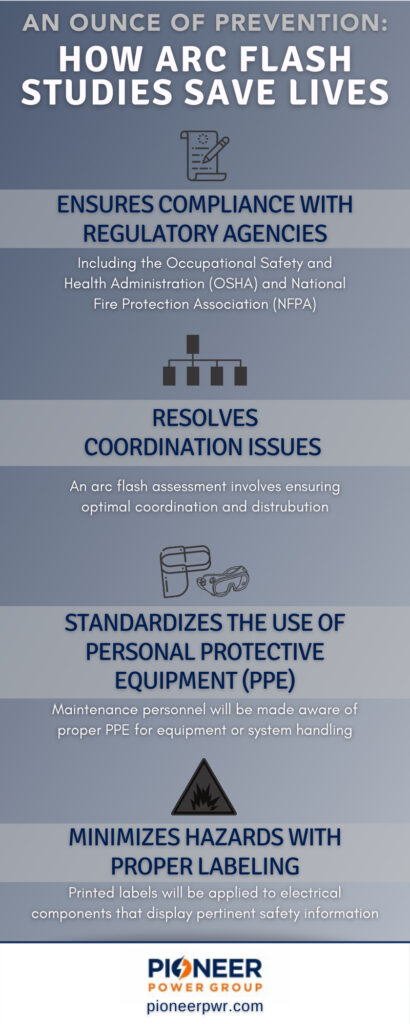Our electrical professionals understand the potential dangers of working with live electrical equipment and unfortunately most individuals do not. The truth is one incident can result in a fatal arc flash explosion. However, electrical safety training and adherence to proper procedures help you avoid harmful accidents. Today, we’ll take a look at ways arc flash studies can save lives.
Ensures Compliance with Regulatory Agencies
OSHA 1910.333, .335 mandates all employers to provide electrical safety for their employees and any contractors. Moreover, the National Fire Protection Association (NFPA) guideline NFPA 70E demonstrates the implementation of an electrically-safe working environment. By complying with these agencies, both employees and qualified personnel can feel confident that their facility is a safe place to work.
Resolves Coordination Issues
An arc flash assessment determines levels of incident energy exposure that employees could encounter. The electrical distribution system in its entirety is reviewed for proper coordination, as well.
Whether it’s a smaller system or a more extensive electrical system, the circuit breaker should trip where the fault occurs. If this does not happen on a larger scope, the fault travels through the electrical system to the main switchboard instead of tripping where the fault actually occurred. This is considered poor coordination.
In a situation like this, an entire plant could be without power — and the cost to the facility could be staggering. Our team reviews coordination issues within an electrical distribution system and provides recommendations to ensure optimal coordination within any given facility.
Resolves Coordination Issues
An arc flash assessment determines levels of incident energy exposure that employees could encounter. The electrical distribution system in its entirety is reviewed for proper coordination, as well.
Whether it’s a smaller system or a more extensive electrical system, the circuit breaker should trip where the fault occurs. If this does not happen on a larger scope, the fault travels through the electrical system to the main switchboard instead of tripping where the fault actually occurred. This is considered poor coordination.
In a situation like this, an entire plant could be without power — and the cost to the facility could be staggering. Our team reviews coordination issues within an electrical distribution system and provides recommendations to ensure optimal coordination within any given facility.
Standardizes the Use of Personal Protective Equipment (PPE)
A thorough risk assessment makes maintenance personnel aware of what level of PPE to wear. This could range from minimal PPE, such as safety glasses and voltage-rated gloves; or it could involve suits that offer 100% body protection. An arc flash analysis establishes the various levels of protection required to work safely and efficiently.
Minimizes Hazards with Proper Labeling
A printed arc flash label compliant with NFPA and National Electrical Code (NEC) guidelines will be applied to electrical components included in an arc flash analysis, and feature information qualified personnel needs to know before performing live work. Information displayed includes crucial information such as Shock Boundary, Arc Flash Boundary, Working Distances, and more.
For more information about arc flash analysis, reach out to our team today!

